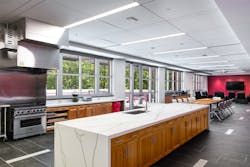The apparatus, turnout gear and equipment advancements over the past 20 years are obvious. Each area was prompted by operations safety and efficiency. Similarly, over 20 years, advances in fire stations were slower, that is until 10 years ago. The goals of health and safety in fire stations have escalated quickly.
Going back thru 21 copies of fire station design awards programs, from 2001 to 2022, the past proves the importance of health and safety in fire stations is progressing quickly. Since the first fire station design awards program, we see innovations in fire station entries every year. Since it averages 3-4 years to design and build a station, innovations are incorporated or added before opening.
Training—In 2001, Fire Chief magazine introduced the first Station Style award program. Among the entries, the first career Gold Award winner was the Delhi, OH, Township Main Fire Station. Completed in 2002, Delhi’s station was on the cutting edge of innovations for fire stations entered. The station had a separate area for turnout gear storage, laundry and decontamination rooms. The station included 6,000 square feet of space for future growth. That was 21 years ago.
According to the 2001 award program judges, the most impressive element of the Delhi station was the fire department’s investment in education and training for the staff. A multifunctional 40-foot training tower included numerous features for training options. Delhi’s station was the first example of the Training by Design concept by Delhi’s architect, David Acomb, AIA, formerly with Cole + Russell Architects.
Fire Station Sprinklers—Fire sprinklers in fire stations were first proposed in the early-90s. “How can we encourage citizens to install fire sprinklers if we don’t have them in our stations?” a legendary West Coast fire chief asked. It was 2019 before every entry in the Firehouse Station Design Awards program had fire sprinklers
Air Quality—Used to be that fumes in apparatus bays were just part of a fire station. Slowly, air quality concerns eventually were addressed, and air quality was designed into stations. In 2016, research on the air quality in Boston fire stations, funded by NIOSH and the National Institute of Health, reinforced the link between air quality and exposure “may” contribute to cancer risks in firefighters in fire stations. The 2020 entries in the Station Design award program each had one or two air quality systems and even separate systems for PPE storage rooms and decontamination areas.
Green and Sustainability—In 2005, the “greening” of fire stations was more than just recycling. Municipalities across the nation were requesting green options for new construction, particularly, the U.S. Green Building Council’s Leadership in Energy and Environmental Design (LEED). While LEED popularity increased over a dozen years, the most recent Station Design Award entries do not include LEED. Architects report fire departments follow the LEED guidelines but don’t submit to the certification process.
Shared Facilities—Prompted by the “recession” in 2008 and the closing of fire stations, local governments looked at consolidating public safety into one facility. Thirteen years later, economics and the increasing joint responses of fire and police could be fortified by shared training, fitness, and classroom facilities.
Bath and Sleeping—An increase in women firefighters required separate bathrooms and adjustments to sleeping areas. After a decade, every award entry addresses unisex or “gender-neutral” bathrooms and an increase in individual sleeping rooms. There are pros and cons to each, but the bottom line is it is addressed in every fire station design submitted.
Decontamination—In 2009, we saw segregated laundry rooms for PPE and station wear; outside access to decontamination areas or away from living quarters; more sophisticated training systems integrated into the facility; and LED lighting.
Hot Zone—Maybe one of the most significant changes to fire stations was in 2014, which addressed firefighter health and safety. The introduction of red/yellow/green Hot Zone design was introduced, and in addition, research revealed the stats on firefighter cancer and mental health. Paul Erickson, FAIA, LeMay Erickson Willcox, introduced the Hot Zone design concept at the 2014 Firehouse Station Design Conference in Baltimore.
Over eight years, the impact of Hot Zone design has had a dramatic impact on firefighter health and safety and continues today.
Look around your current fire station. How well does it protect and serve your personnel and your community? Whether you have a new, renovated or older fire station, take a walk around and see how you can improve the environment for your firefighters, EMS personnel, emergency vehicle technicians and civilian employees. These men and women are the assets you need to provide a healthy environment because you can’t afford to lose them.
About the Author
Janet A. Wilmoth
Special Projects Director
Janet Wilmoth grew up in a family of firefighters in a suburb of Chicago. Wilmoth, who is owner of Wilmoth Associates, worked with Fire Chief magazine for 27 years until it closed in 2013. She currently is the project director for Firehouse, overseeing the Station Design Conference.

